1. Steinmetz KL, Spack EG. The basics of preclinical drug development for neurodegenerative disease indications. BMC Neurol. 2009; 9(Suppl 1):S2. PMID:
19534731.

2. Smith D, Broadhead C, Descsotes G, Fosse R, Hack R, Krauser K, Pfister R, Phillips B, Rabemampianina Y, Sanders J, Sparrow S, Stephan-Gueldner M, Jacobsen SD. Preclinical safety evaluation using nonrodent species: an industry/welfare project to minimize dog use. ILAR J. 2002; 43(Suppl):S39–S42. PMID:
12388850.

3. Meunier LD. Selection, acclimation, training, and preparation of dogs for the research setting. ILAR J. 2006; 47(4):326–347. PMID:
16963813.

4. Smith D, Combes R, Depelchin O, Jacobsen SD, Hack R, Luft J, Lammens L, von Landenberg F, Phillips B, Pfister R, Rabemampianina Y, Sparrow S, Stark C, Stephan-Gueldner M. Optimising the design of preliminary toxicity studies for pharmaceutical safety testing in the dog. Regul Toxicol Pharmacol. 2005; 41(2):95–101. PMID:
15698532.

5. Phillips B, Smith D, Combes R, Descotes G, Dyring Jacobsen S, Hack R, Kemkowski J, Krauser K, PWster R, Rabemampianina Y, Sparrow S, Stephan-Gueldner M, von Landenberg F. An approach to minimise dog use in regulatory toxicology: production of a best practice guide to study design. Altern Lab Anim. 2004; 32(S1):447–451.

6. Swallow J, Anderson D, Buckwell AC, Harris T, Hawkins P, Kirkwood J, Lomas M, Meacham S, Peter A, Prescott M, Owen S, Quest R, Sutcliffe R, Thompson K. Guidance on the transport of laboratory animals: Report of the transport working group established by the Laboratory Animal Science Association (LASA). Lab Anim. 2005; 39:1–39. PMID:
15703122.
7. Kuhn G, Lichtwald K, Hardegg W, Abel HH. The effect of transportation stress on circulating corticosteroids, enzyme activities and hematological values in laboratory dogs. J Exp Anim Sci. 1991; 34:99–104. PMID:
1742341.
8. Burkholder WJ. Use of body condition scores in clinical assessment of the provision of optimal nutrition. J Am Vet Med Assoc. 2000; 217:650–654. PMID:
10976293.

9. Fillman-Holliday D, Landi MS. Animal care best practices for regulatory testing. ILAR J. 2002; 43:S49–S58. PMID:
12388852.

10. Ha CS, Son HY, Kang BY, Cha SW, Park JI, Han SS. A study of hematology and serum chemistry in beagle dogs. Korean J Lab Anim Sci. 1995; 11(2):153–158.
11. Balls M, Amcoff P, Bremer S, Casati S, Coecke S, Clothier R, Combes R, Corvi R, Curren R, Eskes C, Fentem J, Gribaldo L, Halder M, Hartung T, Hoffmann S, Schectman L, Scott L, Spielmann H, Stokes W, Tice R, Wagner D, Zuang V. The principles of weight of evidence validation of test methods and testing strategies. Altern Lab Anim. 2006; 34(6):603–620. PMID:
17266393.

12. Jeong EJ, Han SC, Cha SW, Lee HS, Ha CS, Kim CY. Hematological and blood biochemical values of laboratory beagle dogs. Lab Anim Res. 2007; 23(3):223–229.
13. Matsuzawa T, Nomura M, Unno T. Clinical pathology reference ranges of laboratory animals. Working Group II, Nonclinical Safety Evaluation Subcommittee of the Japan Pharmaceutical Manufacturers Association. J Vet Med Sci. 1993; 55(3):351–362. PMID:
8357905.
14. Ikeuchi J, Yoshizaki T, Hirata M. Plasma biochemistry values of young beagle dogs. J Toxicol Sci. 1991; 16:49–59. PMID:
1886172.

15. Matsuzawa T, Nomura M, Yonezawa H, Unno T. Selection of appropriate parameters, use of a quality control concept, and suitable statistical analyses for clinical pathology examination of animals in toxicity studies: results of a current survey by the Japanese Pharmaceutical Manufacturers Association. Comp Haematol Int. 1995; 5:196–200.

16. Gonder JC, Laber K. A renewed look at laboratory rodent housing and management. ILAR J. 2007; 48(1):29–36. PMID:
17170493.

17. Sharp J, Zammit T, Azar T, Lawson D. Stress-like responses to common procedures in individually and grouphoused female rats. Contemp Top Lab Anim Sci. 2003; 42(1):9–18. PMID:
12580569.
18. Ferasin L, Ferasin H, Little CJL. Lack of correlation between canine heart rate and body size in veterinary clinical practice. J Small Anim Pract. 2010; 51:412–418. PMID:
20553373.

19. Nunamaker E, Newhall K, Thompson C, Lucas A, Owens J, Sherman JG. Safety evaluation and treatment affect of LY2190416, a CB-1 antagonist/inverse agonist in growing beagle dogs. J Vet Pharmacol Ther. 2011; doi:
10.1111/j.1365-2885.2011.01280.x.

20. Shin JW, Park HJ, Kwon M, Son CG. Scientific evaluation of the herbal medicine CGX in beagle dogs. Food Chem Toxicol. 2010; 48:743–749. PMID:
20034534.
21. Wolford ST, Schroer RA, Gohs FX, Gallo PP, Brodeck M, Falk HB, Ruhren R. Reference range data base for serum chemistry and hematology values in laboratory animals. J Toxicol Environ Health. 1986; 18:161–188. PMID:
3712484.

22. Posen S, Doherty E. The measurement of serum alkaline phosphatase in clinical medicine. Adv Clin Chem. 1981; 22:163–245. PMID:
7027760.

23. Amacher DE, Higgins CV, Schomaker SJ, Clay RJ. Further characterization of serum alkaline phosphatase from male and female beagle dogs. Enzyme. 1989; 42:1–7. PMID:
2776712.
24. Uchiyama T, Tokoi K, Deki T. Successive changes in the blood composition of experimental normal beagle dogs associated with age. Jikken Dobutsu. 1985; 34(4):367–377. PMID:
4085564.
25. Bayard SP. Another look at the statistical analysis of changes during storage of serum specimens. Health Lab Sci. 1974; 11:45–49. PMID:
4808617.
26. Caisey JD, King DJ. Clinical chemical values for some common laboratory animals. Clin Chem. 1980; 26:1877–1879. PMID:
7438435.

27. Kaspar LV, Norris WP. Serum chemistry values of normal dogs (beagles): associations with age, sex, and family line. Lab Anim Sci. 1977; 27(6):980–985. PMID:
599888.
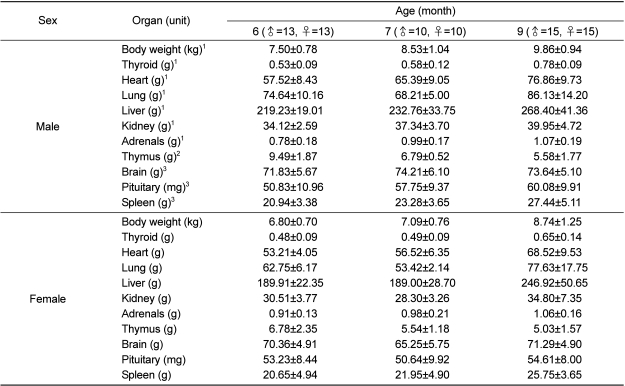
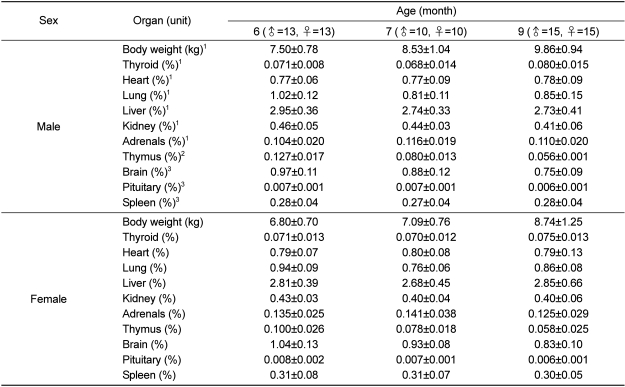

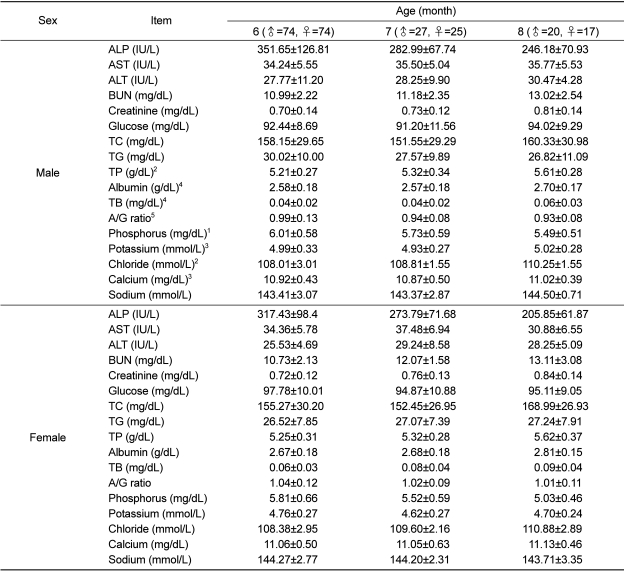




 PDF
PDF ePub
ePub Citation
Citation Print
Print


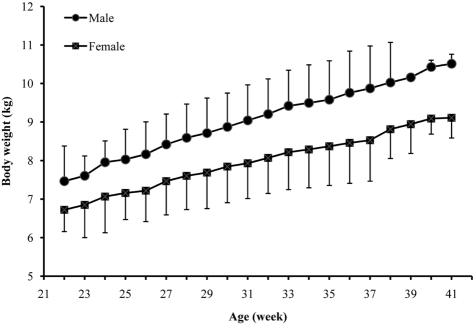

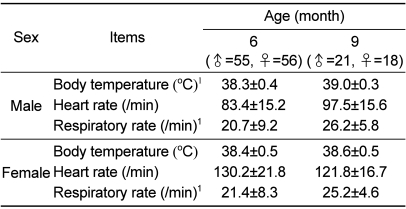


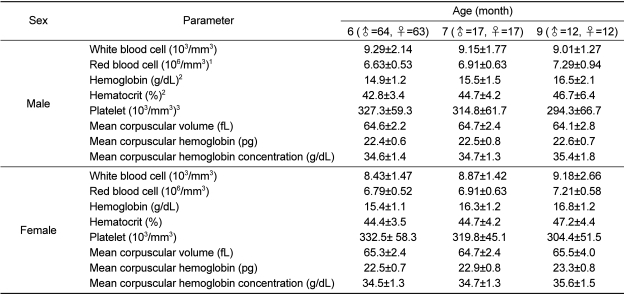
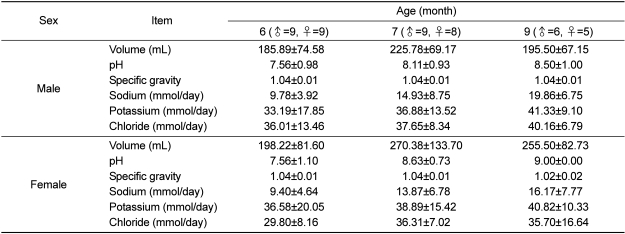
 XML Download
XML Download